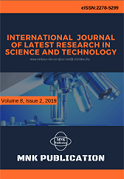DOI:10.29111/ijlrst ISRA Impact Factor:3.35, Peer-reviewed, Open-access Journal
Research Paper Open Access
International Journal of Latest Research in Science and Technology Vol.1 Issue 2, pp 60-64,Year 2012
Correspondence should be addressed to :
Received : 10 July 2012; Accepted : 02 August 2012 ; Published : 31 August 2012

| Download | 125 |
|---|---|
| View | 177 |
| Article No. | 10768 |
Constructed wetland is a natural treatment system that physical, chemical and biological processes occur when water, soil, plants and microorganisms interact. Constructed wetlands treat different types of wastewaters such as agricultural, municipal, and industrial. In this study, Vertical Flow Subsurface Constructed Wetland (VFSSCW) was applied and examined at mesocosmic level for the removal efficiency of Nitrogen and Phosphorus from livestock effluent by using sandbed as substrates planted with Phragmites karka (Reed grass) and Vetivera zizanioides (Vetiver grass).The removal of N & P within wetlands is performed generally by plant uptake and by adsorption onto sediments. VFSSCW design system was designed for retention capacity of 130 liters for about 3 days. The removal efficiency is higher in Phragmites karka compare to Vetiveria zizanioides.
Copyright © 2012 Rawal et al. This is an open access article distributed under the Creative Commons Attribution 4.0 International (CC BY 4.0) license which permits unrestricted use, distribution, and reproduction in any medium, provided the original work is properly cited.
Rawal, Nidhi, Billore, S.K., Makvana K.S. , " Comparison Of P. Karka and V. zizanioides Species For Livestock Effluent Treatment Through Vertical Flow Constructed Wetland ", International Journal of Latest Research in Science and Technology . Vol. 1, Issue 2, pp 60-64 , 2012

MNK Publication was founded in 2012 to upholder revolutionary ideas that would advance the research and practice of business and management. Today, we comply with to advance fresh thinking in latest scientific fields where we think we can make a real difference and growth now also including medical and social care, education,management and engineering.

We offers several opportunities for partnership and tie-up with individual, corporate and organizational level. We are working on the open access platform. Editors, authors, readers, librarians and conference organizer can work together. We are giving open opportunities to all. Our team is always willing to work and collaborate to promote open access publication.

Our Journals provide one of the strongest International open access platform for research communities. Our conference proceeding services provide conference organizers a privileged platform for publishing extended conference papers as journal publications. It is deliberated to disseminate scientific research and to establish long term International collaborations and partnerships with academic communities and conference organizers.